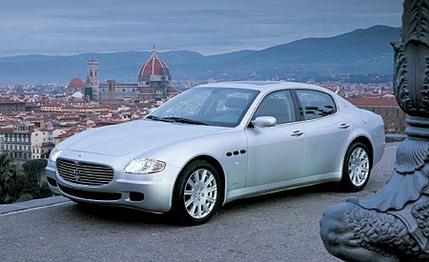
 First Drive Review
First Drive Review
It's styled by Italy's Pininfarina, it wears a price somewhere north of 100 large, and its name means "four doors."
Despite the commonplace moniker, the fifth-generation Quattroporte reeks of presence, individuality, classy conservatism, and drive-me desirability. It's clear that Pininfarina has achieved Maserati's ambition of creating a prestigious Italian rival for the Audi A8 and S8, Jaguar XJR, Mercedes E55 and S55, and BMW 745i.
With the four-cam V-8 located behind the front axle, the car looks big from the side. The 120.6-inch wheelbase (0.9 inch shorter than an S-class's) and extended doors are clearly evident. Parent company Ferrari located the engine aft of the front axle to create a 47/53 front-to-rear weight distribution, as in the new Ferrari 612 Scaglietti.
The Maser's driving complexity begins with the fixed door handles. Behind each are two buttons. Touch the gray one, and it releases the door electrically; the black one, requiring more pressure, does the job manually, perhaps in case the electrics go fizz. The cabin is Italianate-tasteful, chic-with all the luxury toys. There's a vast array of materials: rosewood, mahogany, or briarwood, or a titanium finish; 10 Poltrona Frau leathers using 13 stitching colors, 10 on the dash; and 15 exterior colors.
The power seats are as comfortable as they appear sporting. Rear-seat space is more E- than S-class, very relaxing for two. But that's not where we want to be. The nearly vertical steering wheel is adjustable for reach and height. Rather than go the infamous iDrive route, the Italians prefer dedicated dashboard buttons for the stereo, trip computer, telephone, dashboard monitor, and nav system.
Turn the key, and there's a moment's delay, followed by a long whirring sound from the starter before the V-8 fires with an automatic blip of the throttle. The transmission (there's no clutch pedal; it's a robotic manual with automated shifting and clutch) defaults to the automatic-shift mode. Select drive, press the accelerator, and go. Called Cambiocorsa in the Coupé and DuoSelect in the Quattroporte, it's the only transmission choice. On a light throttle, gearshifts are smoother than in the Coupé and almost as fluent as a conventional automatic. But as you add power, the shifting action becomes increasingly hesitant, and full-throttle shifts at the 7500-rpm redline are downright abrupt.
Flick a switch to engage manual mode, and gearchanging is done via paddles behind the steering wheel-left for downshifts, right for upshifts. There's more complexity: The "Sport" button on the steering wheel firms up the electronic dampers and quickens gearchanges-and it stays in gear, even as the engine hits its rev limiter, instead of upshifting. Learn to feather the throttle at each upward gearchange, and progress is smoother. The gearbox is slow from drive to reverse and back again. We can't help wondering how the Quattroporte would behave if it worked through a traditional torque converter and six-speed automatic.
The 4.2-liter V-8's a belter. Maserati claims marginally more power here than in the Coupé or Spyder (394 horsepower versus 385) but the same 333 pound-feet of torque. Still, a new air filter, revised camshaft profiles, a modified engine-control map, and a new exhaust system have flattened the torque curve at low revs. No matter where you are on the rev counter, the engine never makes less than 221 pound-feet of twist.
These four-doors go from 0 to 62 mph in 5.2 seconds, according to the factory. The soundtrack is a rising crescendo of induction and exhaust music across the entire rev range. Top speed is 171 mph, Maserati says. Powerful though it is, the V-8 blends this stirring performance with terrific flexibility and refinement. Yet the combination of a weight of about 4250 pounds and plenty of revs results in extreme fuel consumption: 9 mpg on Europe's city cycle.
The sports-car weight distribution, the new unequal-length control-arm suspension, and the mounting of the electrically assisted steering rack in front of the axle line are intended to endow the Quattroporte with exceptional agility. It failed to meet expectations. The car is clearly most comfortable on fast, open roads. There it feels settled, poised, and responsive. In tighter second-and-third-gear country, the steering feels comparatively slow, with 3.1 turns lock-to-lock. The leisurely turn-in worsens the mild understeer, but the speed-variable weighting is just right, with enough communication for the driver to feel a part of the action.
There's also plenty of grip, at least in the dry, and the car feels smaller and lighter than the specs suggest. One theoretical advantage of the rearward weight bias is improved traction, but despite massive rubber-285/40ZR-18 tires at the rear-motoring over wet tarmac requires care, especially if you're brave enough to disengage the stability-control system.
The electronically controlled suspension is Maserati's second-generation Skyhook system. It adds throttle and steering angles to its range of senses. These help the suspension read road conditions and driver mood for the fast-adjusting shock absorbers to work out the best possible setting. The ride is always firm. Low-frequency wallows and road crowns are soaked up, but overall the ride quality is patchy. The suspension copes well with larger bumps and longitudinal ridges but lacks the ability to damp out small, sharp bumps. The big car sometimes feels skittish over transverse imperfections, such as railroad tracks.
The Quattroporte, due out in August, is close to being the great Italian sedan of Maserati's dreams, probably closer than we thought possible. Yes, it is flawed, but in so many ways the new sedan remains an irresistible combination, a viable alternative to German luxury sports sedans and to Jaguar's XJR.